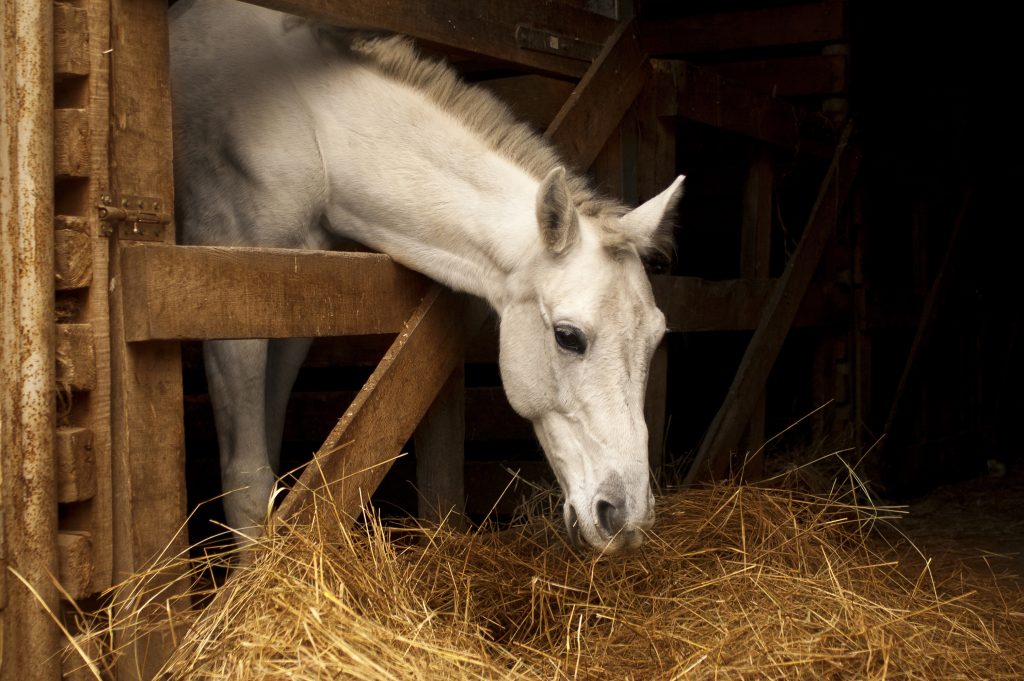To improve your horse’s digestive and mental health, consider bedding his stall with straw.
A new study from Germany suggests that horses kept on edible bedding exhibit feeding behaviors closer to those found in a natural setting, which may reduce their risk of developing colic, gastric ulcers and stereotypies such as cribbing and weaving.

Previous research has shown that horses with continual access to pasture spend most of their 24-hour day grazing—never pausing from eating for more than four hours at a time. This continuity facilitates proper digestive function and keeps the horse occupied. “Major deviations from the natural feed intake behavior, including prolonged pauses, lead to disorders such as abnormal repetitive behavior and stereotypies such as crib biting or weaving,” explains Miriam Baumgartner, Postdoc, of the Technical University of Munich in Freising. “Several studies confirm that a lack of roughage is one of the main causes of behavioral disorders in horses.”
Unfortunately, confinement to a stall interferes with a horse’s natural grazing patterns. To determine to what extent, the researchers observed 104 horses on 10 farms. The horses, crossbreds of varying ages with no health or dental issues, were kept in stalls on either an edible bedding (straw) or an inedible bedding (wood chips), with an average of six hours of turnout every day.
Over several days, the researchers monitored each horse’s eating behavior during the evening hay meal—delivered between 3:30 p.m. and 7:00 p.m., depending on the farm. In addition to noting how long it took the horses to finish their allotment of hay, the researchers recorded the number and duration of pauses in chewing that lasted longer than one minute. The horses were observed until midnight or when they finished their hay.
All horses in the study received roughly the same amount of hay, though it was not precisely measured: “The farmers did not weigh the evening hay meal and we did not determine the exact hay amount in the study, either,” says Baumgartner. “The reason for that was that we feared that a weighing of each prepared evening hay meal might introduce an undesired selection bias of the feeding farmers. They might have altered the amount of hay (deliberately or not) they typically fed.”
The resulting data showed that horses on the straw bedding ate their hay more slowly than those on shavings, taking more frequent breaks. What’s more, says Baumgartner, when the horses on straw finished eating their hay, they would then nibble on the straw, extending their overall grazing time. While straw is not as nutritious as hay, it is safe for horses to eat and can be a source of beneficial roughage.
In contrast, the horses on wood shavings paused less frequently while consuming their hay meal and did not have anything to eat once finished. As a result, the data showed that 74.3. percent of the study horses on wood shavings had overnight feeding pauses of more than four hours between the time they finished their evening meal and their morning hay arrived.
The mean average duration of nighttime pauses in feeding behavior in this group was eight hours and 50 minutes, and one horse had an overnight pause of more than 13 hours.
“It is evident that straw, as a source of roughage, has benefits for the horses’ welfare,” the researchers conclude. “If straw is used as a bedding material, the horses engage with it in a higher frequency and duration. In particular, the horses eat the bedding and spend less time standing motionlessly or being inactive/unengaged. The result of a current study is that roughage supply significantly influences the horses’ welfare if they are housed individually. If hay is fed restrictively, straw as bedding prevents dietary deprivations of horses.”
If straw bedding is not available, says Baumgartner, owners can take other steps to prolong a horse’s feeding behavior while he’s confined to a stall. “Hay can be offered in hay racks or hay nets ad libitum. If the horse has a predisposition to be overweight, low-energy and high-fiber hay is preferable. Moreover, small openings in a hay net help to decrease the feeding rate and thereby increase the time horses spend eating per day.”
Reference: “Common feeding practices pose a risk to the welfare of horses when kept on non-edible bedding,” Animals, March 2020
Don’t miss out! With the free weekly EQUUS newsletter, you’ll get the latest horse health information delivered right to your in basket! If you’re not already receiving the EQUUS newsletter, click here to sign up. It’s *free*!








